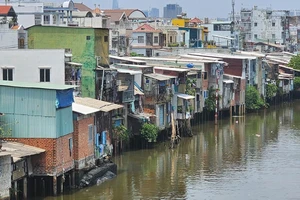Ho Chi Minh City needs about VND1,000 trillion (US$44 billion) for infrastructure development in the phase of 2015-2030, said a representative of the city People’s Committee at a meeting yesterday.

The meeting was hosted by the city Department of Transport and HCMC Finance and Investment State-Owned Company (HIFC) to seek capital mobilization measures for infrastructure development from 2016-2021.
Raising other capital resources amid the existing state budget limitation is the key to boost infrastructure investment, said the representative.
Annually, the funds for traffic development come from the city budget, official development assistance (ODA) and investors. The third source has been increasing but still limited. During the phase of 2011-2015, it contributed VND11.95 trillion making up 31 percent of the total fund of VND38.61 trillion. The city budget and ODA sources were VND26.66 trillion accounting for 69 percent, according to reports at the meeting.
Dr. Huynh The Du, director of Fulbright economics teaching program in HCMC, said that HCMC has been in unfavorable position in budget because it has been permitted to keep a too little amount of yearly revenues.
He proposed pilot implementation of a special administrative model for Thu Thiem new urban area to test supply modes of modern public services, put forward initiatives for regional connectivity, build a breakthrough program on urban planning and development in line with public transport system.
HCMC should creatively apply Public Private Partnership (PPP), thoroughly consider risks related to this model and proposed use forms of land taxes and fees and enhance the role of existing financial organizations especially HFIC.
Dr. Tran Du Lich suggested the city to take advantage of the profitable urban land fund during urbanization process.
The city should ask for mechanisms to use capital resources from real estate sector, equitization of state owed enterprises (SOEs) and their divestment from non-core fields and call on other social resources for urban infrastructure development, he said.
HCMC needs to have an own and strong financial model like HFIC. The role of HFIC should be promoted at the maximum level to efficiently use state capital, mobilize other funds, manage and use of SOE equitization income to invest in the city’s infrastructure.
The most important thing is that the central government should facilitate policy and institution breakthroughs for the city to promote its dynamism and creativeness for comprehensive development, Dr. Lich said.
Dr. Nguyen Thi My Linh from the HCMC Industrial University said that the city should clear barriers in site clearance and legal framework to lure foreign investors.
Cooperation rules signed

At the meeting, the Department of Transport and HFIC signed a set of cooperation statues to mobilize investment in urban infrastructure.
According to the statues, the two sides will exchange information, create land fund and timely meet capital demand for the city’s key projects in the upcoming time.
HFIC Director General Pham Phu Quoc said that the company is the city’s strategic public financial institution attracting capital for infrastructure and important fields.
During the phase of 2010-2015, HFIC financed VND14.01 trillion ($628.21 million) for 131 infrastructure projects.
Besides traditional investment forms, HFIC is stepping up collaboration with capable investors to implement PPP infrastructure projects, focusing on those in the public investment list approved by the city People’s Council and seven breakthrough programs of HCMC.
Deputy Chairman of the city People’s Committee Tran Vinh Tuyen appreciated the rules and required HFIC to swiftly build a capital mobilization project for the city’s infrastructure.
The company should continue promoting its role of the city’s strategic investor and initiate non-state capital mobilization for the city's infrastructure development and key programs.
























